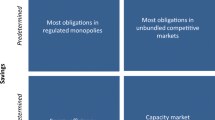Abstract
End-use energy efficiency is a cost-effective and rapidly deployable strategy for significantly reducing greenhouse gas (GHG) emissions and energy costs. Energy savings certificates (ESCs)—instruments assigning the property rights to energy savings or attributes of those savings—are becoming an effective tool for meeting energy savings and GHG targets. The efficacy of ESCs will depend on the market’s ability to (1) verify the amount of savings that they certify along with the uncertainty of those savings (i.e., quantify their value), (2) clearly assign ownership rights to that value (i.e., state exactly who owns what) and (3) efficiently buy and sell those rights between interested parties (i.e., conduct simple transactions). The measurement and verification (M&V) system governing ESCs will critically impact whether these three criteria are satisfied. An M&V system for ESCs requires the fundamental elements of an M&V system for any regulated energy-efficiency program, but must also address more explicitly the above-mentioned criteria. In this paper, the authors discuss the International Performance Measurement and Verification Protocol (IPMVP) and specific elements of an M&V system that address components of an ESC system.
Similar content being viewed by others
Notes
For an excellent overview of ESCs, the authors direct the readers to Hamrin et al. (2007)
Seconday markets might include such financial instruments as bundled loans or other securities
Approximately 300 individuals have been CMVP-certified at time of writing. Training has been conducted in South Africa, Taiwan, and China. EVO recently completed its first “train-the-trainer” course in Taiwan. This marks the first attempt to create a sustainable source of trained professionals to conduct IPMVP-standard M&V. See www.evo-world.org for more on EVO’s training.
“Standard calculations” are accepted engineering algorithms that support energy savings estimates
The double coincidence of wants problem is an important category of transaction costs that impose severe limitations on economies lacking money and thus dominated by barter or other in-kind transactions. The problem is caused by the improbability of the wants, needs or events that cause or motivate a transaction occurring at the same time and the same place. The term “double coincidence of wants” is attributed to William Stanley Jevons (Ostroy and Starr 1990, p. 24).
“Lemon,” as used here means a defective or unsatisfactory product. In American English it is commonly applied to used cars. George Akerlof’s 1990 paper on “The Market for Lemons: Quality Uncertainty and Market Mechanisms” discusses the failure of the used car market.
References
Akerlof, G. (1970). The market for lemons: Quality uncertainty and market mechanisms. Quarterly Journal of Economics, 84(3), 488–500.
American Society of Heating, Refrigerating and Air-Conditioning Engineers (ASHRAE). (2002). Guideline 14–2002 – Measurement of Energy and Demand Savings. Retrieved October 15, 2007, from http://resourcecenter.ashrae.org/store/ashrae/newstore.cgi?itemid=9012&view=item&categoryid=310&categoryparent=310&page=1&loginid=13470967.
Association of Issuing Bodies (AIB). (2007).The Principles and Rules of Operation of the European Energy Certificate System (EECS), Version 4. Retrieved October 15, 2007, from http://www.aibnet.org/portal/page/portal/ AIB_HOME.
Bertoldi, P., & Kromer, S. (2006, August). Risk Assessment in Efficiency Valuation: Concepts and Practice. (Paper presented at the ACEEE Summer Study, Monterey, California).
California Public Utilities Commission (CPUC). (2006). California Energy Efficiency Evaluation Protocols: Technical Methodological and Reporting Requirements for Evaluation Professionals. Retrieved October 15, 2007, from http://www.cpuc.ca.gov/PUC/energy/electric/Energy + Efficiency/.
California Public Utilities Commission (CPUC) and California Energy Commission (CEC). Database for Energy Efficiency Resources (DEER). Retrieved October 15, 2007, from http://eega.cpuc.ca.gov/deer/.
Coase, R. H. (1960). The problem of social cost. Journal of Law and Economics, 3, 1–44.
Efficiency Valuation Organization (EVO). (2007). International Performance Measurement & Verification Protocol, Volume I: Concepts and Options for Determining Savings. Retrieved October 15, 2007, from www.evo-world.org.
Hamrin, J., Vine, E., & Sharick, A. (2007). The Potential for Energy Savings Certificates (ESC) as a Major Tool in Greenhouse Gas Reduction Programs. Report for The Center for Resource Solutions. Retrieved October 15, 2007, from http://www.kendall.org/publications/reports/ESC.pdf.
Mathew, P., Kromer, J. S., Sezgen, O., & Meyers, S. (2004). Actuarial pricing of energy efficiency projects: Lessons foul and fair. Energy Policy, 33, 1319–1328.
Meyers, S., & Guthrie, S. (2006, August). More and Faster: Increasing the Achievable Energy Efficiency Potential through Best-Practice Processes and Data Management Tools (Paper presented at ACEEE Summary Study, Monterey, California).
Meyers, S., & Kromer, S. (2006, August). Energy Efficiency at Enron Energy Services: A Surprising Place for a Success Story (Poster presented at ACEEE Summary Study, Monterey, California).
Mundaca, L., & Neij, L. (2007). Transaction costs of Energy Efficiency Projects: A Review of Quantitative Estimates, European Commission Intelligent Energy Programme, EuroWhiteCert Project Retrieved 30 September, 2007, from http://www.ewc.polimi.it.
North American Association of Issuing Bodies (NAAIB). (2007). NAAIB_FAQ.pdf Retrieved on 30 September, 2007 from http://www.resource-solutions.org.
Ostroy, J. M., & Starr, R. M. (1990). The Transactions Role of Money. In B. Friedman, & F. H. Hahn (Eds.), Handbook of Monetary Economics, Volume 1 (Chapter 1) North-Holland, Amsterdam.
Ridge, R., Kromer, S., Meyers, S., Mahone, D., Luo, J., Richardson, V., et al. (2007, August). Energy Efficiency Portfolio Risk Management: A Systematic, Data-Driven Approach for Timely Intervention to Maximize Results (Paper presented at International Energy Program Evaluation Conference, Chicago, Illinois).
Acknowledgements
The authors would like to thank EVO and its supporters, subscribers and user-community for their continued support.
Author information
Authors and Affiliations
Corresponding author
Rights and permissions
About this article
Cite this article
Meyers, S., Kromer, S. Measurement and verification strategies for energy savings certificates: meeting the challenges of an uncertain world. Energy Efficiency 1, 313–321 (2008). https://doi.org/10.1007/s12053-008-9019-5
Received:
Accepted:
Published:
Issue Date:
DOI: https://doi.org/10.1007/s12053-008-9019-5




